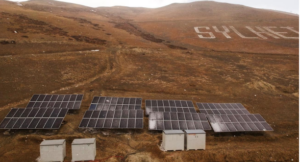GS3 – Science & Technology

Context
Researchers at IIT Bombay have developed an innovative solar-powered thermal battery that captures and stores solar heat in summer for use during the cold Himalayan winters.
What is a Solar-Powered Thermal Battery?
A device that stores solar thermal energy chemically for long durations and releases it as heat when needed. It uses:
- Solar thermal collectors: Capture and concentrate sunlight to heat air
- Reactor chamber: Filled with strontium bromide (SrBr₂)
- Air circulation system: Regulates chemical reactions for charging and discharging
Technology Base:
- Based on Thermochemical Energy Storage (TCES) — unlike sensible (hot water) or latent (phase change) storage, this stores energy via chemical reactions
Role of Strontium Bromide (SrBr₂)
- Why chosen?
- High energy density
- Chemically stable and non-toxic
- Not explosive and environmentally safe
- Nature:
- A white, crystalline compound
- Also used in flares and pharmaceuticals
How It Works
- Charging Phase (Summer – Energy Storage)
- Solar collectors heat the air
- Heated air is passed over hydrated strontium bromide
- The salt dehydrates (endothermic reaction), storing energy in chemical form
- Discharging Phase (Winter – Heat Release)
- Moist air is passed through dehydrated salt
- Salt rehydrates (exothermic reaction), releasing the stored heat
- This heat is used for space heating, especially useful in Himalayan winters
Significance & Potential Impact
- Seasonal Storage: Can retain heat for months, enabling summer-to-winter energy use
- Sustainable Alternative:
- Replaces diesel heaters and firewood in Himalayan homes
- Reduces pollution, cost, and carbon footprint
- Clean Energy Innovation:
- Makes use of abundant solar radiation during summers
- Ideal for remote, off-grid regions
About Thermochemical Energy Storage (TCES)
- Working Principle:
- Stores energy through reversible chemical reactions
- Involves bond-breaking (charging) and bond-forming (discharging) processes
- Phases of Operation:
-
-
- Charging (Dehydration)
- Storage
- Discharging (Rehydration)
-
- Advantages:
- Minimal energy loss over time
- More efficient than conventional thermal storage for long durations
- Global Status:
- Piloted in Germany and other countries
- In India, practical deployment is still in pilot/testing stage




